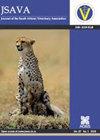6个月大的波美拉尼亚犬的线状肌病。
IF 0.9
4区 农林科学
Q3 VETERINARY SCIENCES
Journal of the South African Veterinary Association
Pub Date : 2022-06-01
DOI:10.36303/jsava.2022.93.1.498
引用次数: 0
摘要
摘要线状肌病是一种临床和遗传上复杂的异质性疾病,在人类中不常见,在动物中也很少见,其特征是进行性肌肉无力。通过组织学和/或超微结构鉴定,在超过40%的骨骼肌纤维中发现肌鞘下、线状、杆状结构,称为线状杆状体,可确诊。这些杆状体含有z线蛋白α-肌动蛋白,可以用Gomori或Masson三色法在骨骼肌中有效染色,并用周期性酸-希夫法负染色。在患有内分泌紊乱的狗身上也发现了少量类似的杆状体,在人类的其他情况下也偶尔发现。本报告是一只6个月大的博美犬,在两个月的时间里,它出现了进行性运动不耐受,并伴有严重的胸肢废用性肌肉萎缩,以及逐渐的骨盆肢体无力和食物反流。基线诊断排除内分泌病变,胸肢肌肉和神经活检的组织学和超微结构评估证实了线状肌病。临床过程、诊断试验结果、骨骼肌和周围神经的超微结构、大体尸检结果和各种染色的组织病理学均作了描述和说明。本文章由计算机程序翻译,如有差异,请以英文原文为准。
Nemaline myopathy in a six-month-old Pomeranian dog.
ABSTRACT
Nemaline myopathy - a clinically and genetically complex heterogenous group of disorders - is described uncommonly in humans and rarely in animals, and is characterised by progressive muscle weakness. The diagnosis is confirmed by histological and/or ultrastructural identification of subsarcolemmal, thread-like, rod-shaped structures called nemaline rod bodies within more than 40% of skeletal muscle fibres. These rods contain the Z-line protein, α-actinin, that can be effectively stained in skeletal muscles using Gomori or Masson trichrome and negatively stained with periodic acid-Schiff. Similar rod-like bodies have been found in smaller numbers in dogs with endocrine disorders and occasionally in other conditions in humans. This report is of a six-monthold Pomeranian dog which had progressive exercise intolerance over a two-month period associated with severe disuse muscle atrophy of the thoracic limbs, as well as gradual pelvic limb weakness and regurgitation of food. Baseline diagnostics ruled out endocrinopathies and after histological and ultrastructural evaluation of thoracic limb muscles and nerve biopsies confirmed nemaline myopathy. The clinical course, diagnostic test results, ultrastructure of skeletal muscle and peripheral nerve, gross necropsy findings and histopathology using various stains are described and illustrated.
求助全文
通过发布文献求助,成功后即可免费获取论文全文。
去求助
来源期刊

Journal of the South African Veterinary Association
VETERINARY SCIENCES-
CiteScore
1.50
自引率
0.00%
发文量
23
审稿时长
22 weeks
期刊介绍:
The Journal of the South African Veterinary Association is a contemporary multi-disciplinary scientific mouthpiece for Veterinary Science in South Africa and abroad. It provides veterinarians in South Africa and elsewhere in the world with current scientific information across the full spectrum of veterinary science. Its content therefore includes reviews on various topics, clinical and non-clinical articles, research articles and short communications as well as case reports and letters.
 求助内容:
求助内容: 应助结果提醒方式:
应助结果提醒方式:


